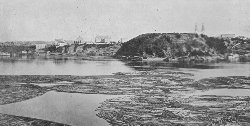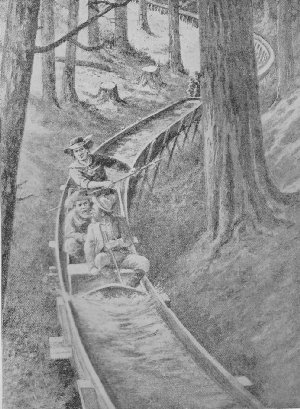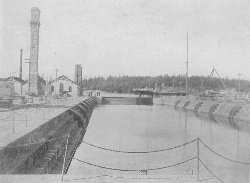|
In early times the forests of Canada extended in an almost unbroken stretch from the Atlantic ocean to the head of Lake Superior, a distance of 2,000 miles.
The reputation of Canada as a "wooden country" rests primarily on the fame of its white pine in the province of Ontario. The chief lumber riches in the province of Quebec consist of spruce, with some pine and birch timber, and cover an area of 48,000 square miles. In New Brunswick the area of timber land under license is 6,000 miles. To British Columbia, however, belong the trees most admired in the lumber trade and out of it. Its red cedar is one of the most valuable of timbers. Its forest area is 285,000 square miles, or 182,400,000 acres, and it is really the timber province of Canada. Along the coast of British Columbia is grown its most valuable wood—the Douglas fir—which has no competitor in length, strength and straightness. Some of the trees grow to a height of more than 300 feet, and have a circumference of over 50 feet, thus approximating the size of the colossal redwoods of California. The Douglas fir is likely to prove a valuable paper making tree. British Columbia also contains species of spruce, hemlock, cottonwood, balsam, white pine and red cedar. The last named is, for general purposes, the most valuable wood on the Pacific coast, where all these varieties are to be found.
In British Columbia flumes are used to float logs from mountain tops to sawmills. The loggers nail boards together and come down the same way, traveling sometimes a mile a minute. In this province are 60 great sawmills, with a daily capacity of more than 3,000,000 feet of lumber. The yearly cut of British Columbia is 75,000,000 feet. In the depth of winter the mill owners, who lease the timber land from the government, send out large gangs of laborers to fell the huge pine and other trees, previously marked by "explorers," preparatory to making them into square timber or saw logs.
If saw logs are being cut, they are hauled over cliffs and down ravines to the banks of the various tributaries of the principal rivers, where, before the thaw sets in, millions of cubic feet of timber are collected. When the ice-bound streams are free in the spring, the logs, loosely joined together in rough rafts, are set adrift in the rivers, some of the rafts in New Brunswick covering a space of ten acres. The method of camping, cutting the trees, getting them to the mills and working them up into the various forms of marketable lumber is substantially the same as that pursued in the timber regions of the United States, and described in the article entitled "Logging in the Northwest." The maple (Acer), whose leaf is the emblem of Canada, is a lofty tree, with particularly luxuriant foliage. The wood is very close-grained and hard, highly ornamental, and is esteemed for the beauty of its fibre. When polished it possesses a silky lustre. It is used for heavy furniture, cabinet work, and for railway carriages, where strength is required. AGRICULTURE IN CANADA In the vast plateau stretching westward through Upper Canada, on both sides of Lake Erie, farming is a comparatively easy vocation. The yield of wheat is abundant in the southern portion, but north of the wheat limit the land is poor and rocky. In the wheat region, cattle and dairy products also constitute large items in the farmer's receipts. It is the general practice to allow the land to remain for two years in artificial grasses and clover, to break it up in June, and sow wheat in autumn. The only formidable foes encountered by the Canadian farmer in raising wheat are rust and mildew, which early sowing largely prevents. When these are absent, the comparatively high temperature of the autumn pushes forward the wheat plants, and produces a thick carpet of vegetation. On the inferior lands some fine crops of Indian corn are grown, being planted in May and maturing about the middle of September. Much of the soil in Lower Canada is a dark-colored sandy loam. Timothy grass grows well on it, but the clovers only last one year. Oats, barley and potatoes are the staple crops in the island of Montreal and other parts. There is a variable breadth of alluvial soil along the banks of the St. Lawrence River, but for some miles west of Quebec, little arable land is observable. The area of first-class farming land in Canada east is not extensive. The deposits of swamp muck found more or less in all parts of Canada, result from gradual accumulation of partially decomposed vegetable matter—the remains of successive generations of plants, chiefly aquatic. These deposits furnish the farmer a liberal supply of plant food for his crops. If dug in autumn, thoroughly aired, exposed to the winter's frosts and then mixed with lime or marl and wood ashes, the compost is much valued as a fertilizer by the Canadian farmer. Marl, which is essentially carbonate of lime, is chiefly found in connection with the muck beds, and when readily obtained is the cheapest article which the farmer could use for the purpose. The production of wheat in Canada for the year 1902 was 87,555,891 bushels. This amount gives the Dominion the ninth place in a list of 22 of the great wheat-producing countries of the world, the combined crop of which, in 1902, was 2,820,333,614 bushels. The Canadian census of 1890 showed that the number of persons engaged in agricultural pursuits in the Dominion of Canada—farmers and farmers' sons—was then 649,506. These and their families then made up 45 per cent of the entire population of the country. The very low prices which prevailed for wheat and the coarse grains for some years after the taking of the 1890 census, led a large number of farmers to turn their attention to more profitable methods of disposing of these crops than by their bulk sale in the markets. About that time a central experimental farm, with several branches, was established by the Dominion parliament for the purpose of making agricultural tests whose results would enable the farmers to derive more profit from their labors. The experiments conducted at the government farms demonstrated the fact that wheat, as well as other grains, might be made a greater source of profit by converting them into beef and pork than by selling them in their crude state, and this course was pursued on numerous farms with pronounced success. The investigations made under government supervision also showed that the feeding of these grains, mixed with suitable succulent food, such as ensilage, to cows and converting their milk into cheese and butter was more profitable than selling the grain. In consequence of this, the dairying industry grew very rapidly, and the demand for first-class dairy products became almost unlimited. The Canadian farmers enjoyed a double advantage as a result of the change of method, in that the elements of fertility taken from the land during the growth of their grain crops were largely restored to the soil by the barnyard manure. Moreover, when buttermaking was carried on during the winter months, additional employment was given to farm hands during that season, and the oversupply of grain fed to cattle and swine, reduced the excess on hand and tended to restore the equilibrium of the market. The experimental farms not only tested the varieties of grains, but furnished the farmers proper seed samples for general growth, thereby improving the quantity and quality of the various cereals grown in Canada. These newer and more productive sorts of grain are rapidly replacing some of the less prolific varieties formerly cultivated. OSTRICHES AND OSTRICH FARMING |


